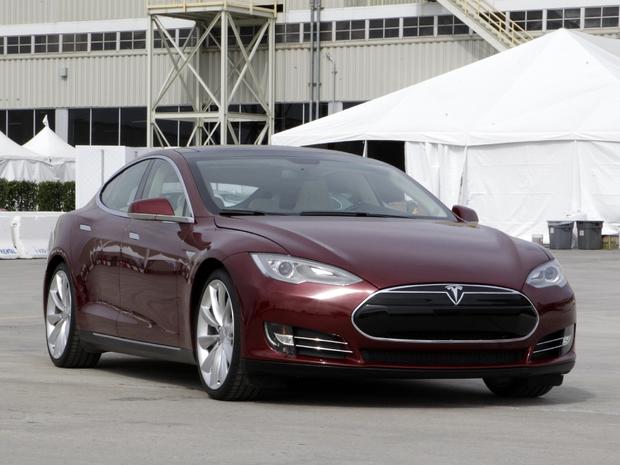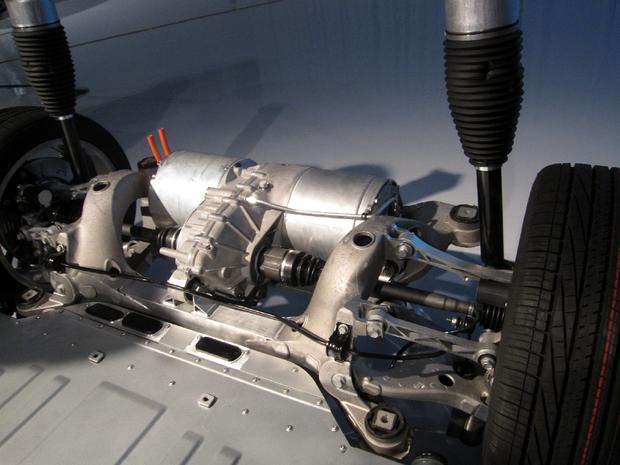A glimpse at the future in Tesla's Model S Beta 1
At events over this last weekend and the following Monday, Tesla gave its customers and a group of journalists an opportunity to see the beta of its Model S, the new electric sedan it intends to put into production early next year. I joined this happy few, but knew going in that, unlike most automotive model introductions, I wouldn't actually get to drive the car.
Getting into the passenger seat, one of the first things I noticed, along with every other journalist present at this event, was that the stalk-mounted drive selector was the same as found in new Mercedes-Benz cars. Apparently, the electric power steering unit and associated steering gear, which includes column and stalk controls, was provided by automotive equipment maker ZF. Jim Dunlay, VP of powertrain engineering, assured me that, by production, Tesla would have its own drive selector, along with any other controls that might share sourcing with another automaker.
And that shifter illustrates what Tesla means by calling this Model S a beta, and why I wouldn't get my hands on the wheel, not this day. Tesla made much of its transparency, how other automakers would never let you see a model in this early stage of development. The car was one of five in this early run, built at a contracted plant in Detroit. The next phase, the Beta 2, will be built in Tesla's new Fremont, California factory. 50 of these cars will be built starting this month. The Beta 2 model will not only help Tesla employees further refine the car, but it will also test the new production facility.
Not that this Beta 1 Model S wasn't quite far along. Electric drivetrain, check. Steering wheel, check. Tires, check. Nicely finished interior, check. The car, referred to as Beta 1 by Tesla, even had a basically working infotainment system in the center stack and fully digital instrument panel. There were still many details to work out, such as the shifter, infotainment interface programming, and tuning, but this Beta 1 was a working car.
Proof is in the drive
As Tesla employee Graham Sutherland piloted the Model S beta through a short slalom, the first part of the course laid out for this ride along, he explained how the low slung battery contributed to excellent stability. Having seen the unique layout of the car in cutaway fashion, he didn't need to tell me, relegated to the passenger seat, how that weight distribution and the big, flat battery assembly would help the car handle. As Sutherland is responsible for the car's suspension he was privy to much more interesting information.
Noticing a bit of sway in those first maneuvers, I began asking him about the suspension tuning, currently a work in progress. According to Sutherland, Tesla CEO Elon Musk wants the Model S to have the handling of a Porsche and the comfort of an Audi. Those are fairly high bars to set, especially given the conventional suspension technology supporting the car, double wishbones in front and a multilink configuration in back. No air suspension, no magnetic ride technology.
But the ride quality did feel quite smooth, that sensation probably enhanced by the car's lack of a combustion engine. Take out the rumble of repeated explosions occurring right in front of the passenger compartment, and the car already has a huge advantage on the luxury front.
The next section of the course was a straightaway, where Sutherland made real use of the accelerator. The Model S, although much bigger than the Roadster, delivered the push. I was pressed into the seat as the car quickly hit 60 mph, then 70, and up to 80 before we had to slow down.
As I've experienced in other electric cars, acceleration was smooth and inexorable, unhampered by gears and engine speed changes. The only surprise here was how well Tesla's electric drive technology scaled up to the bigger car. The Roadster, which takes some contortions to get into, has a battery pack that looks like a refrigerator and a motor the size of a watermelon.
The Model S, on the other hand, has its batteries in a flat, approximately four inch thick assembly bolted underneath the car. The motor, sitting on the rear axle, is a little bigger than that of the Roadster. Still using what are essentially lithium-ion laptop batteries, Tesla packs enough of them into the flat casing, along with a liquid cooling system, to produce 85 kilowatt-hours, or 300 miles range for the car.
The electric motor is rated at 362 horsepower and 306 pound-feet of torque, that latter number available from 0 to 7,000 rpm. It gets the Model S to 60 mph in 5.6 seconds. At the weekend unveiling, Elon Musk revealed that Tesla would also create a sport version of the Model S, which gets to 60 mph in under 4 seconds.
I had no trouble believing that Tesla's drive configuration for the Model S would work, but it was nice to feel it pushing the car down the test course. Tesla replaced faith with proof. Sutherland finished the course with a few fast loops on Tesla's own factory test track, which includes banked turns.
Luxury right out of the gate
The cabin of this Model S looked far nicer than I would expect of a first beta. It had a glass roof with a retractable portion. The leather covered seats felt comfortable. All of the doors closed with a reassuringly soft click.
But really striking about the interior was its simplicity. The dashboard and other surfaces lacked the switchgear I am used to used to seeing in most cars. Sure, there were window controls in the doors, a couple of clickable scroll wheels on the steering wheel spokes, and the drive selector. But most of the cabin controls appeared on the large center touchscreen, a big infotainment interface which Elon Musk likened to an iPad.
Brennan Boblett, in charge of the interface design, showed off a number of the system's features. A row of icons at the top allowed access to different vehicle functions, such as phone, navigation, and the stereo. The upper half of the screen could show navigation, courtesy of Google Earth, with the bottom showing music, phone, or other functions. Or navigation could be moved to the lower half, with a Web browser on top. The demonstration also showed how the map could take up the entire screen.
Boblett demonstrated Slacker radio integration, although cautioned that Tesla had not finalized any deals with app developers. The system is supposed to store music locally, and include advanced voice command that lets you select music by saying the name of an artist, similar to Ford's Sync.
With the car's data connection, it downloads Google Earth imagery to show the car's location. As it downloads a chunk consisting of 300 miles radius around the car, more than the car's own range, it should always have satellite imagery available. But Tesla will also include a standard navigation system licensed from Navigon.
Linux underlies this infotainment system, and only takes up 35 mb, according to Boblett. And powering it is a Tegra2 chip from Nvidia, a graphics processor no bigger than a dime, but hugely powerful. By the time the Model S hits production, it should be using the Tegra3 chip.
A separate Tegra2 chip powers the car's instrument panel. Tesla does away with analog gauges completely, settling for a flat pane of glass behind the steering wheel with virtual representations of gauges for speed, range, and other useful information. Both infotainment interface and instrument panel will undergo tweaking up until the time the software needs to be loaded onto the first Model S to roll off the production line.
The electric world
The obvious progress Tesla has made on the Model S assures the company will hit its production plan, which is actually very modest. Only 5,000 units of the Model S are slated for the first year's production, despite the fact that Tesla has already logged 6,000 orders. The following year the company goes into full production, yet still only plans 20,000 cars per year, which is the capacity of its planned production line working a single shift each day.
With a base price of $57,400, before any credits, the Model S looks like a good value proposition. However, a base model will only have a range of 160 miles. Tesla estimates that the 300 mile range version will cost about $77,400. Tesla has not suggested any other content differences besides range for the different versions.
Tesla has already announced it is working on a second car for its model line-up, the Model X, which will take the form of a crossover. It is expected to be more affordable than the Model S.


